Summary of the UNDRR Multi-Stakeholder Forum on “Early Warnings for All (EW4All)” 2–6 June 2025
The Global Multi-Stakeholder Forum on Early Warnings for All (EW4All) took place in Bonn. It aimed to foster inclusive, anticipatory, and localized disaster preparedness systems. The forum followed the UN Secretary-General’s call for everyone on Earth to be protected by an early warning system by 2027.
- Early Warning as a Guarantee, Not a Goal
- Early warning systems should be accessible to all, especially in vulnerable, conflict-affected, and climate-fragile areas.
- Warnings must be timely, actionable, and tailored to local realities—from technology to trust.
- “What good is a warning that comes too late or never comes at all?” — WMO Secretary-General Celeste Saulo
- Governance and System Comprehensiveness
- Good governance is directly correlated with the effectiveness of early warning systems.
- Countries with more comprehensive DRR strategies (as tracked by the Sendai Framework Monitor) had more evenly distributed capabilities across the four pillars of early warning: risk knowledge, monitoring/forecasting, dissemination, and preparedness/response.
- Fragmented approaches result in weak, unsustainable systems.
- Inclusive and People-Centered Approaches
- The marginalized (women, people with disabilities, Indigenous groups, youth) must be included as co-creators, not just recipients.
- There was strong advocacy for “nothing about us without us,” emphasizing community ownership.
- Empathy, trust, local knowledge, and user-centered design were emphasized over technical-only solutions
- Channelizing policy propagation ( bottom-up) from the Last Mile to the Central bureaucratic paradigm
- The “last mile” (reaching remote or marginalized people) must become the priority: The “last mile” stakeholders ( local governments, private sector actors, civil society, and communities) led micro-level policy and programmatic transitioning, policy propagation, much needed interventions design, which should be well adopted & mainstreamed by the centralized government machinery ( in regular short & medium term planning & fiscal budgeting process) and acted upon accordingly, with locally led early action, not just the implementation of external directives.
- Financing and Private Sector Engagement
There is a call to shift from ad hoc, reactive funding to prearranged, predictable local financing.
- The private sector was identified as a critical actor in resilient infrastructure, continuity planning, and local investment.
- Investing in early warning systems is a high-return investment, not a humanitarian donation.
- Technological Innovation and Accessibility
- Technology such as AI, satellite-based systems, and mobile alerts is advancing, but its real impact depends on accessibility and usability.
- Tech solutions must align with social realities and be translated into timely action on the ground
- Fragile and Conflict Settings
- Special sessions focused on challenges in fragile and conflict-affected areas.
- Civil society organizations were recognized as vital connectors, able to deliver services and build trust where states cannot.
- Transboundary and Regional Collaboration
- Early warning systems must be interoperable across borders and regions.
- Regional mechanisms (e.g., African Union, IGAD) were urged to lead transnational risk coordination.
- Stakeholder Engagement Mechanism (SEM)
- The Sendai SEM involves 21 constituencies (NGOs, academia, private sector, Indigenous peoples, etc.).
- This structure ensures non-governmental voices are part of monitoring and implementing disaster risk reduction strategies
- Institutional and Political Will
- Leaders emphasized that early warning must become an institutionalized service, not a project.
- There is growing political alignment, seen in countries committing through their National Adaptation Plans (NAPs) and DRR strategies.
- Local Leadership and Inclusion
- Emphasis on community-led early warning systems that are locally designed, accessible, and inclusive.
- Indigenous knowledge, youth leadership, and marginalized groups must be institutionalized, not tokenized.
- “Turning the last mile into the first smile” – prioritize and empower local actors in disaster risk reduction (DRR).
- Multi-Hazard and Conflict Settings
- Fragile and conflict-affected areas often lack early warning systems.
- Solutions must be adaptable to crisis contexts and ensure humanitarian-development-climate nexus collaboration.
- Governance and Accountability
- Effective early warning systems require inclusive, coordinated, and accountable governance.
- Must be embedded within national frameworks with active stakeholder participation.
- Early warning serves as a unifying platform across climate, DRR, and humanitarian agendas.
- Innovation and Technology
- Strong focus on AI, satellite systems, and impact-based forecasting, while balancing with low-cost tech for accessibility.
- Communities must be co-creators of tech-enabled solutions, not passive recipients.
- Financing
- Sustainable, long-term financing remains a key barrier.
- Early warnings must be integrated into national budgets and not seen as external or donor-dependent.
- Calls for pre-arranged, accessible financing to enable anticipatory action at the local level.
16. Strategic Calls to Action
a) Stronger Partnerships
- Need for “radical collaboration” between traditional and new actors.
- Shared vision and alignment of purpose are essential.
b) Institutionalization of Inclusivity
Embed the role of civil society, indigenous communities, women, and persons with disabilities into the value chain of early warning systems.
c) Accountability Mechanisms
Transparency and joint state-non-state actor frameworks for scaling and sustaining investments.
d) Political Will and Simplification
Calls for cutting red tape and harmonizing donor frameworks to improve access to funds and simplify processes.
Highlighted Reflections from Key Stakeholders
- UNDP, UNDRR, and WMO reinforced the value of people-centered systems and the need for global to local translation.
- National authorities (e.g., Australia, Mali) stressed contextual, risk-informed planning.
- Donors and development agencies (e.g., Norway, Finland, Caribbean Development Bank) emphasized the need for:
- Evidence-based investment,
- Risk-informed budgeting,
- Strong national ownership,
- Local capacity building.
Notable Quotes and Metaphors
- “Early warning is not just a technical issue—it’s about people.”
- “Science saves lives.”
- “The early warning chain is only as strong as its weakest link.”
Conclusion
The forum established a foundation for ongoing collaboration toward universal early warning coverage. Participants underscored that success depends on:
- Institutionalized inclusion,
- Financing that reaches the frontlines,
- Evidence-driven action, and
- Sustained political and community commitment.
The forum marks a mature turning point in disaster risk discourse—transforming it from a technical exercise to a global movement grounded in shared responsibility and community-driven resilience.
Challenges in Achieving Inclusive Early Warnings
Several persistent challenges hinder the full implementation of people-centered early warning systems:
- Lack of Trust and Community Engagement: A significant barrier is the lack of trust between communities and the authorities issuing warnings. This is often compounded by a failure to involve communities, including vulnerable groups like persons with disabilities, women, and indigenous populations, in the design and implementation of these systems. Warnings are often not aligned with local preferences and realities.
- Exclusion of Vulnerable Groups: At-risk groups are frequently not meaningfully included in early warning processes. For instance, persons with disabilities face significant barriers to accessing information and services during disasters. Migrants, both documented and undocumented, the elderly, and children also face unique vulnerabilities that are often overlooked.
- Operational and Technical Issues: Many regions suffer from fragmented coordination among national and regional agencies, outdated monitoring technology, and under-resourced hydro-meteorological services. Data often remains siloed, preventing effective, real-time sharing and accurate forecasting. Furthermore, there is often a failure to translate complex scientific data into actionable information for diverse communities.
- Funding and Sustainability: A major obstacle is the reliance on short-term, project-based financing, which is not sustainable. There is a tendency to make initial solutions overly complex, and a lack of continued funding and a responsible agency can lead to the failure of projects after implementation.
Recommendations for Improvement
To address these challenges, experts recommend the following:
- Build and Maintain Trust: This requires open dialogue, listening to community needs, and understanding local contexts and structures of influence.
- Enhance Policy and Legislation: It’s crucial to have strong policies and legislative frameworks that mandate community engagement and ensure that early warning systems are inclusive.
- Integrate Traditional and Scientific Knowledge: While embracing and respecting traditional knowledge, it’s essential to complement it with scientific data, especially in the context of changing climate parameters.
- Adopt a People-Centered Approach: This means recognizing communities as active participants, not passive recipients of warnings. This includes involving them in preparing evacuation maps and identifying safe areas.
- Strengthen Capacity and Data Integration: Invest in training for national and regional institutions and create interoperable platforms for real-time data sharing across sectors and agencies.
- Secure Long-Term, Coherent Financing: Shift from fragmented, short-term projects to a programmatic approach that ensures sustainability and broadens partnerships to include private capital and multilateral support.
Examples of Implementation and Best Practices
Several initiatives and projects illustrate these principles in action:
- The Caribbean: The Caribbean Disaster Emergency Management Agency (CDEMA) has developed a model multi-hazard early warning systems policy and legislation for its 20 member states that is community-centered. They have also modified global checklists to better integrate gender considerations and the role of major social groups.
- Nepal: The Nepal Red Cross Society works to make forecasts understandable for local communities and religious leaders, who are often trusted figures.
- Colombia: In an informal urban settlement, a landslide early warning system was successfully implemented by working closely with the community, integrating technical instruments into public spaces to create a sense of ownership and care.
- Kenya: In a village in Kenya, community members are engaged in risk mapping and documenting local resources to create effective evacuation plans. They also use multiple channels, including local champions, to disseminate information to remote areas.
- Nigeria: The Nigerian Red Cross Society has been working with communities to build their capacity for early warning and early action, using a combination of tools like vulnerability and capacity assessments, focus group discussions, and simulation exercises. They have successfully integrated traditional knowledge with scientific methods.
Call to Action
- Institutionalize inclusive, community-driven early warning systems.
- Strengthen data governance, local capacity, and inter-agency collaboration.
- Shift from fragmented project-based approaches to system-based resilience.
- Integrate early warning across climate, DRR, development, and humanitarian sectors.
- Support locally-led action with resources, financing, and policy power.
This forum marked a mature shift from technical dialogue to a global movement for equity in early warnings. It reaffirmed that resilience is built with communities, not delivered to them.
“Early Warning for All must become more than a goal — it must become a guarantee.”
https://globalplatform.undrr.org
Access live session https://www.youtube.com/watch?v=_gxzUT5FB54
Remote Audiences Comments
- Cost of inaction is much higher than the cost of taking action
- We need to make more efforts to work across silos, actors and engage non-usual suspects to accelerate progress.
- We are a critical mass with a joint mission to make a positive change.
- We NEED more platforms for collaboration, to share data across differing sectors and disciplines AND across differing levels(transnational)
- I should advocate for a multi sector anticipatory action response plan in my country
- The solutions of the past are not the solutions of the future
- We have inclusive approaches and examples – we need to institutionalise inclusivity for EWS now.
- The absolute necessity to ensure the right engagement of stakeholders, institutionalisation of leave no one behind
- Keep EW simple, make is accessible to EVERYONE is way they understand, and collaboration.
- Effective EWS is one that is for all and by all.
- Bringing together humanitarian/development communities with national systems
- Development of Multi-Risk EWS with an intersectional and inclusive gender approach
- We are on the same page, others are not, we need to spread the word, raise finance, and embed warnings in policy for all hazards (natural and human-made)
- Science-government connections for community information
- Increase the interaction with private sector for improve the awareness in the DRR.
- EWS should have a multi-hazard approach and involve effective stakeholder collaboration at national level for ownership, inclusion and sustainable financing
- People-centered EWS
- The importance of localized EWS
- Needs for accelerating the EW4ALL & reduce bureaucracy in financing.
- Government buy-in for appropriate legal framework to benefit from co-financed ODA projects
- Link to communty to EWs
- Let’s use the incredible opportunities of technology, especially mobile networks and reach, to bring alerts to everybody.
- Drastically reduced funding makes stronger coordination necessary. We need synergies beyond silos (and beyond common places & buzzwords!)
- Cell broadcast is a significant opportunity for alert dissemination
- [In French]: Cooperation, cooperation, cooperation! With everyone, at all levels, 360 degrees.
- Collaboration at all levels with all stakeholders to achieve EW4All
- Co- development of early warning withe people most at risk is crucial
- Long-term, co-financed programmes that are inclusive, action-oriented and multi-risk are needed
- More funding, more effective, and sustainable.
- People Centered collaboration
- Coordination Co-financing
- The potential of private finance funding involvement
- Effective EWS is one that is for all and by all.
- Multi-stakeholder and multi-government initiatives
- need to innovate finance
- We need stronger yet simplified, streamlined partnerships
- The absolute necessity to ensure the right engagement of stakeholders, institutionalisation of leave no one behind
- We should talk to the non-converted
- UN to hold the government accountable to make concerted efforts and mandates for a political buy-in of developing an ICT-driven and integrated EWS ( sectors, stakeholders, and climate frontline )
EW4ALL Piller Summarized Thematic Flyer /Flagings :
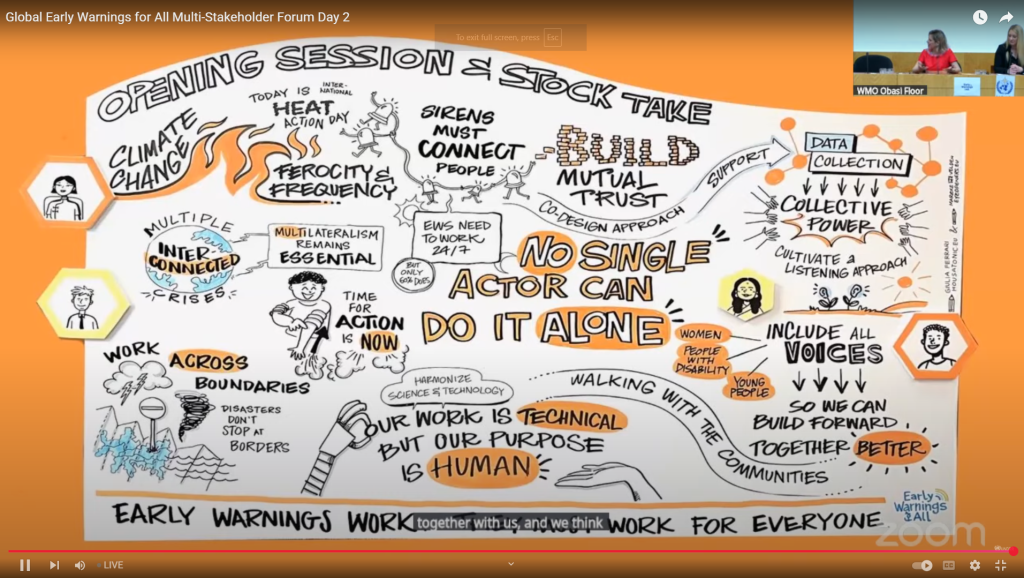
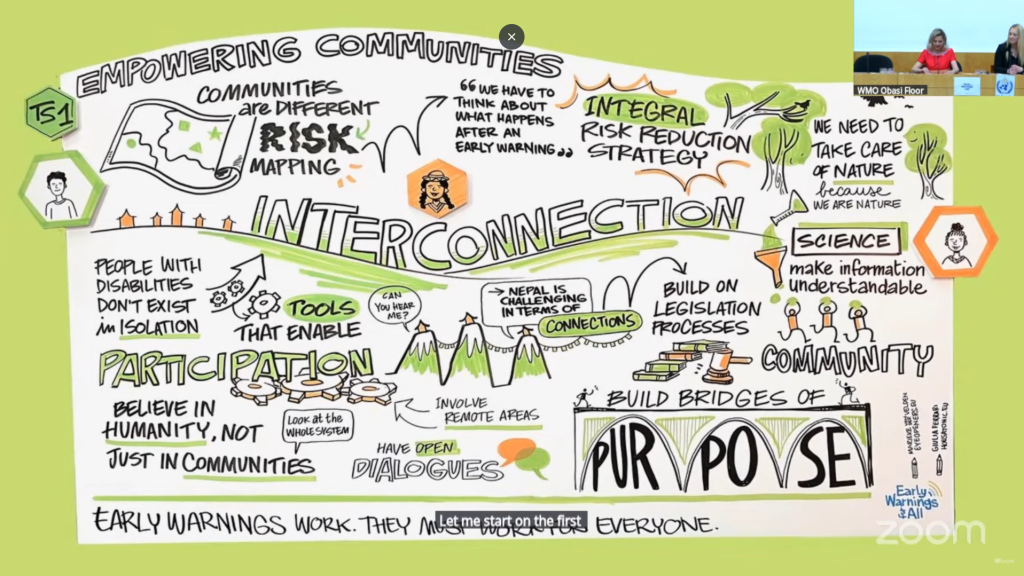
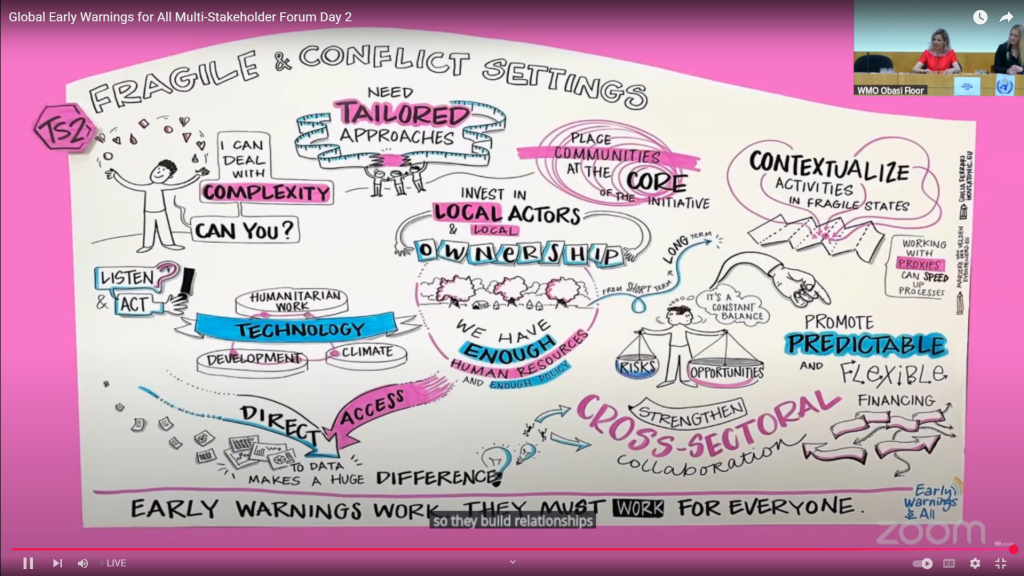
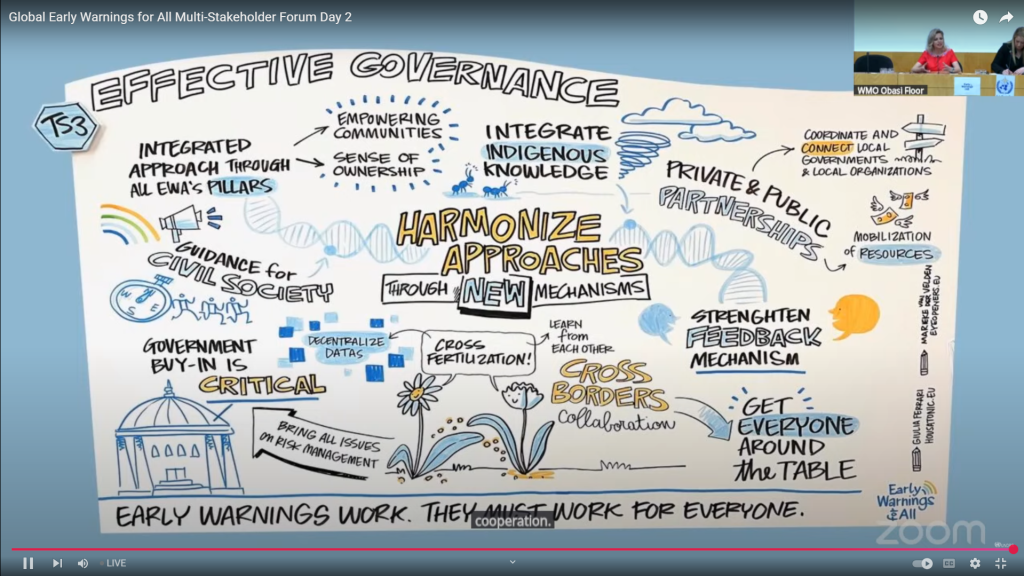
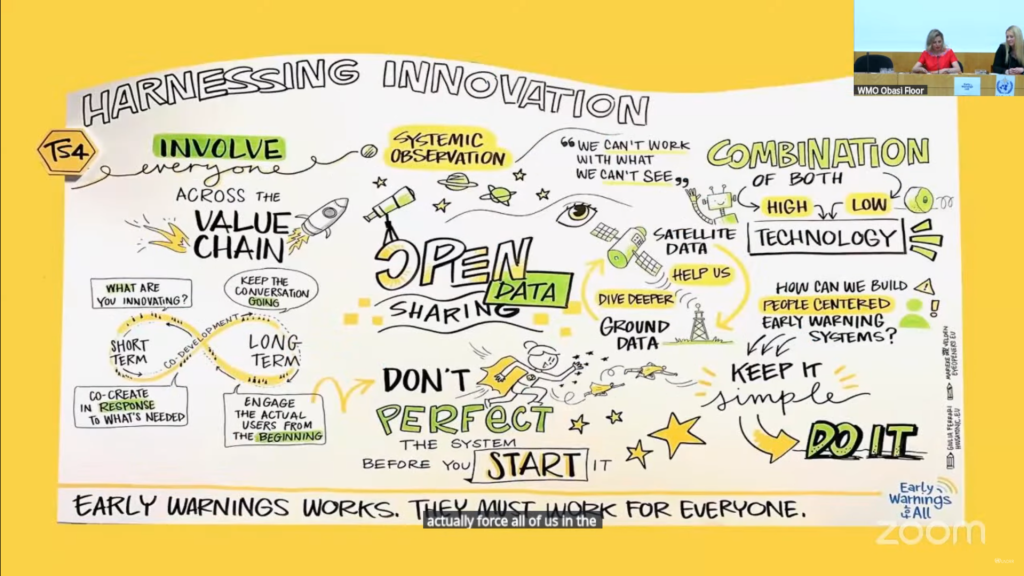
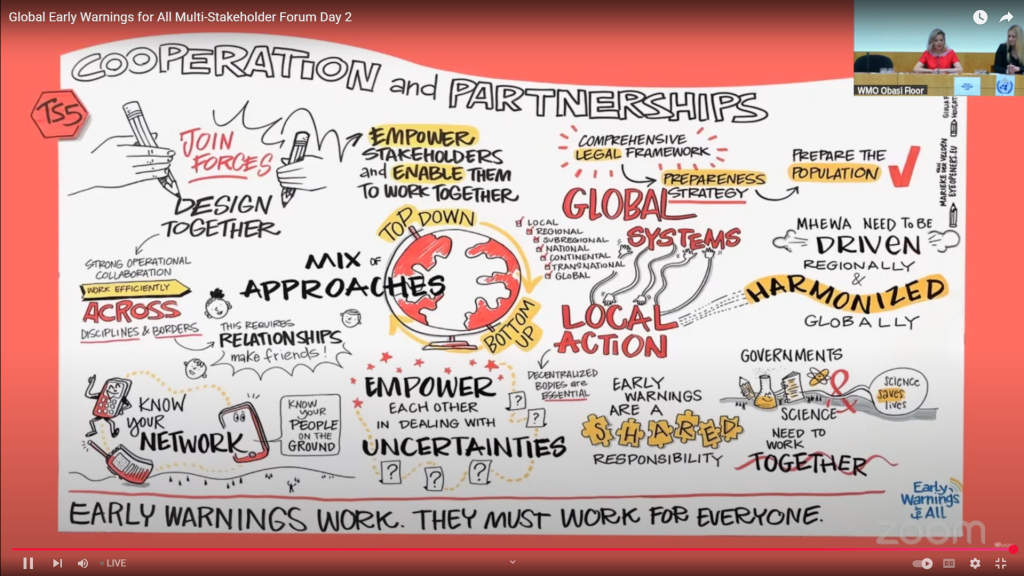
Questions :
Anonymous
1 day ago
3
For Saini Yang: How can state-of-the-art, innovative data technology help improve the researching and understanding of disaster data?
Anonymous
1 day ago
2
How does Kiribati assess the impact of slow-onset processes? Impacts can be in indirect and subtle ways.. thanks.
Anonymous
1 day ago
2
To Tom JRC: how far will INFORM warning build on the existing JRC instruments and support MHEWS and Anticipatory Action?
Anonymous
1 day ago
2
To CCRIF As parametric insurance CCRIF is well placed to enable Anticipatory Action to prevent/mitigate impacts. Any experiences with payouts ahead of disaster?
Anonymous
1 day ago
2
To SADC / MOZ: What role does Anticipatory Action tp prevent/mitigate impacts play for SADC and how can improved transboundary data enable improved AA at scale?
Anonymous
1 day ago
1
What about regional organizations? How can they improve collaboration between local, national, and global data systems?
Anonymous
1 day ago
1
Are there tools to capture non-economic losses? Especially relating to the impact of climate change
Anonymous
1 day ago
1
For CCRIF- are the cat. models that you all use for your insurance products based on historical data or do they account for climate change? Thank you
Anonymous
1 day ago
1
Where do you see the role of National Statistical Offices in improving disaster-risk related data for decision making?
Anonymous
1 day ago
1
Is any experience to use data models for anticipatory actions?
Anonymous
1 day ago
0
How can a global database with interoperability be introduced for disaster risk reduction (DRR)?
Anonymous
1 day ago
0
Parametric insurance is based on financial values, but how are financial values placed on intangible losses, such as loss of cultural heritage?
Anonymous
1 day ago
0
How can we analyse the data to make it actionnable by decision-makers?
LN
Lady N
1 day ago
0
Why many country prefer to complete the smart city data ISO37122 rather than resilient city ISO37123 data. Any comments?
GG
Gaurav Godhwani
1 day ago
0
How can we co-create international data standard for Losses & Damages data?
Anonymous
1 day ago
0
We see big data inequality in terms of availability, specifically in Sub-Sahara Africa. Even more so for granular data. How can regional bodies tackle this?
Anonymous
1 day ago
0
How can citizen science be standardized and integrated into national data tracking systems?
Anonymous
1 day ago
0
For Litea – can you give a concrete example of how you ensure a risk assessment “speaks to” the community for which it is assessing?
Anonymous
1 day ago
0
How can we conduct risk and impact assessments to mitigate loss and fatalities in low and middle-income countries with data sharing and accessibilitychallenges?
Anonymous
1 day ago
0
The missing link I this conversation is data sharing between organisations and government. How we make sure data are shared in a protective and accessible ways
Anonymous
1 day ago
0
In what aspects of DRR are the disaggregated data used?
YO
Yuichi Ono
1 day ago
0
Disaggregated data collection should be done at local levels. If they are not capable, no good such data would be gathered. What are ways to change this?
Anonymous
1 day ago
0
UNESCO/CODATA published their Data Policies in Times of Crises facilitated by Open Science – might this support trusted data?
RM
Razia Mughal
1 day ago
0
How every one affected from disaster can be the part of decision making to ensure inclusion?
Anonymous
1 day ago
0
What is an example of data being re-used after its initial relevancy, outside of the context in which it was originally collected?
Anonymous
1 day ago
0
Yes it is time to tear down silos. But how about addressing underlying issues? Often It is about resources and power related to data. How can this be adressed?
Anonymous
1 day ago
0
How to move from discussion on data use for DRR to real actions in bridging the society needs and policymaking to significantly reduce disaster losses?
Anonymous
1 day ago
0
CCRIF – From your perspective, what is the relevance to collect sector -specific disaggregated and geolocated data?
Anonymous
1 day ago
0
Dr Gupta: How can we ensure accurate damage reporting to manage potential issues of inflated claims from affected communities expecting government compensation?
Anonymous
1 day ago
0
What role should the government play in the collection, processing, availability and use of disaggregated data for DRR at all levels? (edited)
Anonymous
1 day ago
0
What role should the government play in the collection, processing, availability and use of disaggregated data for DRR at all levels? (edited)
Anonymous
1 day ago
0
Dr Gupta: How can we ensure accurate damage reporting to manage potential issues of inflated claims from affected communities expecting government compensation?
Anonymous
1 day ago
0
CCRIF – From your perspective, what is the relevance to collect sector -specific disaggregated and geolocated data?
Anonymous
1 day ago
0
How to move from discussion on data use for DRR to real actions in bridging the society needs and policymaking to significantly reduce disaster losses?
Anonymous
1 day ago
0
Yes it is time to tear down silos. But how about addressing underlying issues? Often It is about resources and power related to data. How can this be adressed?
Anonymous
1 day ago
1
Is any experience to use data models for anticipatory actions?
Anonymous
1 day ago
0
What is an example of data being re-used after its initial relevancy, outside of the context in which it was originally collected?
RM
Razia Mughal
1 day ago
0
How every one affected from disaster can be the part of decision making to ensure inclusion?
Anonymous
1 day ago
0
UNESCO/CODATA published their Data Policies in Times of Crises facilitated by Open Science – might this support trusted data?
YO
Yuichi Ono
1 day ago
0
Disaggregated data collection should be done at local levels. If they are not capable, no good such data would be gathered. What are ways to change this?
Anonymous
1 day ago
1
Where do you see the role of National Statistical Offices in improving disaster-risk related data for decision making?
Anonymous
1 day ago
0
In what aspects of DRR are the disaggregated data used?
Anonymous
1 day ago
0
The missing link I this conversation is data sharing between organisations and government. How we make sure data are shared in a protective and accessible ways
Anonymous
1 day ago
0
How can we conduct risk and impact assessments to mitigate loss and fatalities in low and middle-income countries with data sharing and accessibilitychallenges?
Anonymous
1 day ago
0
For Litea – can you give a concrete example of how you ensure a risk assessment “speaks to” the community for which it is assessing?
Anonymous
1 day ago
0
How can citizen science be standardized and integrated into national data tracking systems?
Anonymous
1 day ago
0
We see big data inequality in terms of availability, specifically in Sub-Sahara Africa. Even more so for granular data. How can regional bodies tackle this?
GG
Gaurav Godhwani
1 day ago
0
How can we co-create international data standard for Losses & Damages data?
Anonymous
1 day ago
1
For CCRIF- are the cat. models that you all use for your insurance products based on historical data or do they account for climate change? Thank you
Anonymous
1 day ago
2
To SADC / MOZ: What role does Anticipatory Action tp prevent/mitigate impacts play for SADC and how can improved transboundary data enable improved AA at scale?
LN
Lady N
1 day ago
0
Why many country prefer to complete the smart city data ISO37122 rather than resilient city ISO37123 data. Any comments?
Anonymous
1 day ago
2
To CCRIF As parametric insurance CCRIF is well placed to enable Anticipatory Action to prevent/mitigate impacts. Any experiences with payouts ahead of disaster?
Anonymous
1 day ago
0
How can we analyse the data to make it actionnable by decision-makers?
Anonymous
1 day ago
2
To Tom JRC: how far will INFORM warning build on the existing JRC instruments and support MHEWS and Anticipatory Action?
Anonymous
1 day ago
0
Parametric insurance is based on financial values, but how are financial values placed on intangible losses, such as loss of cultural heritage?
Anonymous
1 day ago
0
How can a global database with interoperability be introduced for disaster risk reduction (DRR)?
Anonymous
1 day ago
3
For Saini Yang: How can state-of-the-art, innovative data technology help improve the researching and understanding of disaster data?
Anonymous
1 day ago
1
Are there tools to capture non-economic losses? Especially relating to the impact of climate change
Anonymous
1 day ago
2
How does Kiribati assess the impact of slow-onset processes? Impacts can be in indirect and subtle ways.. thanks.
Anonymous
1 day ago
1
What about regional organizations? How can they improve collaboration between local, national, and global data systems?